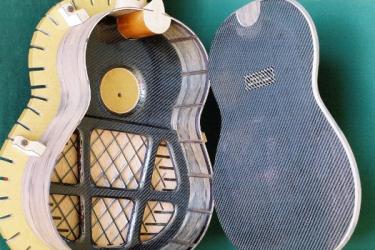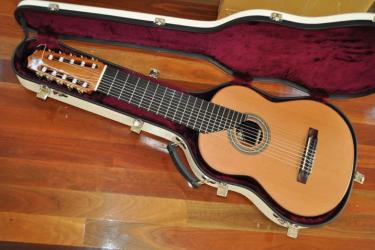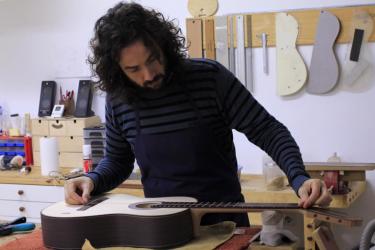I’m delighted to have Eduardo Durán Ferrer from Granada, Spain.
Q1. Could you please tell us a little about your luthiery and its history?
I started around 1982 at the workshop of my father Antonio Durán. I was combining school and learning about guitar making. At that time, there were three more people working at my father's workshop. One of those was Rafael Moreno, my tutor. I learned from him about the handling of tools and steps to follow in this profession. My grandfather Eduardo Ferrer and my father used to teach me the secrets and techniques of guitar building. When I knew almost everything about it (from how to cut a tree, then cut it into pieces, seasoning a wood, how to choose the best wood, and the building) that was when I learned the last part of this profession: The varnishing - I learned this at the workshop of Antonio Marín Montero. And that was when I began making guitars with my own name.
I had already made some but with the name of Antonio Durán at my father's workshop, and supervised by him. I have been making my own guitars for quite a long time and am teaching my son, the fifth generation of guitar makers. The first generation began in 1875 by Benito Ferrer.
Q2. Please describe your idea of a good sounding guitar, and what you do to achieve it?
My idea of a good sounding guitar is a guitar which is well balanced. It is achieved by using good woods, with a suitable thickness for each wood. Each wood requires a different thickness for each guitar depending on its hardness and some other things...
Q3. Please tell us about your idea of improving playability, and what you do to achieve it?
For me, the secret of improving playability is in the building of the guitar. It is when you give a tension that you want the guitar to have, whichever for a classical or a flamenco guitar. When it is known who the guitar is made for, it is possible to handle the strength of a guitarist to adjust the guitar to his touch.
Q4. Please tell us your opinion about the traditional finishing method (French polish) and new methods (lacquer, catalysed finishing, etc).
To be honest, I haven't got much experience with modern varnishes. I only use French polish because, though it is more fragile than synthetic varnishes, I think it's more natural and protects well without affecting the sound.
Q5. Please tell us your opinion regarding shorter-scale guitars such as 640, 628 and 615mm in terms of playability, design, sound quality and volume. Is there an increasing need to cater to smaller-handed or female players?
I only make those guitars on request, usually for Japan and sometimes for small-handed people. In terms of the sound, volume, and the rest, I don't find a difference compared to the ones with a longer scale. I don't have as good ears as the guitarists’ who play them, and it is they who have confirmed that the sound and response of the guitar is similar.
Q6. Many readers say they end up being very confused after trying many guitars. Could you give us some advice on how to examine the guitars' sound quality and playability at a shop or luthier, from the guitar-maker's point of view?
This is a quite difficult matter to respond. In my experience, when a friend guitarist of mine, and he's the best guitarist for me, assesses an instrument for the first time, he spends playing and enjoying for a while its sound, touch, playability, and response. After that, it's when he checks the assembly. My colleagues I talked about before have the same opinion. I'd advise your readers to choose a guitar which makes them feel comfortable to play, and responds to their demand with the sound. It is quite common that people pay to much attention to the name of luthier than the quality of the instrument. In the end, you are going to play "the instrument", not the name of luthier.
Q7. Do you offer any 'after-sales' service to customers - particularly customers who are nervous about making a substantial investment?
Usually, I offer a guarantee for life. This guarantee is against fabrication defects, but not against bad handling of the instrument.
This kind of instrument needs care. Not to play near the heater, not to leave it in the trunk of a car when it's very hot, be careful with the humidity, blows, etc.
Q8. How does the increasing rarity of some woods, rosewood for example, impact on your methods, and the quality of the end product?
It affects the final price of the guitar. For example, "jacarandá" is much more expensive than Indian rosewood.
Here we call it "palosanto de río". This is a commercial name as it covers a variety of woods that are very similar.
Q9. How do you see the future of this beautiful tradition in the 21st century?
I have no idea. I think as long as there are guitarists who need a high-quality guitar, there has to be a luthier who makes it. It is very difficult to introduce the level of customisation we make for each guitar on an industrial scale.





